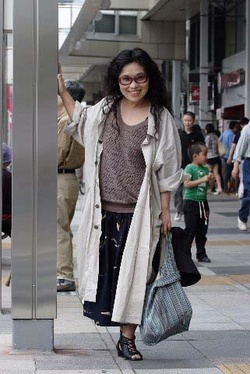Born in Tokyo in 1955, Itō Hiromi is one of the most important women poets of contemporary Japan. Itō rose to prominence in the 1980s with a series of dramatic collections of poetry that described sexuality, pregnancy, and feminine erotic desire in dramatically direct language. Her willingness to deal with touchy subjects such as post-partum depression, infanticide, and queer sexual desire took Japan—a nation more used to images of women as proud wives, mothers, and quiet caregivers—by surprise and earned attention from detractors who decried her lewdness and feminist critics who lauded her as a heroine.
Because she was so willing to write about subjects relegated to the periphery of acceptability by the traditional concern for respectability, Itō quickly became the foremost voice of the so-called “women’s boom” of poetry in the 1980s.1 The poet Kido Shuri has said the following about Itō’s position in contemporary Japanese letters:
The appearance of Itō Hiromi, a figure that one might best call a “shamaness of poetry” (shi no miko), was an enormous event in post-postwar poetry. Her physiological sensitivity and writing style, which cannot be captured within any existing framework, became the igniting force behind the subsequent flourishing of “women’s poetry” (josei shi), just as Hagiwara Sakutarō had revolutionized modern poetry with his morbid sensitivity and colloquial style.2
The comparison between Itō and Hagiwara Sakutarō (1886-1942), a figure sometimes called the “father of modern Japanese poetry,” suggests the colossal importance of Itō’s contribution to contemporary poetry.
In the late 1980s, Itō’s relationship with her husband, the scholar Nishi Masahiko, was failing, and she decided to divorce him and come to America to start anew. One reason Itō chose America in particular was her growing passion for Native American poetry, which she had first encountered a few years earlier in Japanese translations by Kanaseki Hisao. Her interest in Native American poetry eventually led her to the work of Jerome Rothenberg, the avant-garde poet who had published several key collections of Native American poetry and helped make “ethnopoetics” a major force in contemporary American poetic circles. In 1990 Itō met Rothenberg when he visited Japan, and in 1991 she traveled with her two daughters to the University of California at San Diego where he was teaching.
The sojourn in California was a turning point in Itō’s life. She quickly settled into life in America, making friends and building a home, although her somewhat rudimentary English meant that she maintained a strong sense of being a resident alien in a foreign environment. She returned to America several times on a three-month-long tourist visa, but when her visa was set to expire, she returned to Japan temporarily before then turning around and returning to California. In 1997, she finally settled in America permanently with her current partner, the British artist Harold Cohen. Since the late 1990s, Itō has lived in Encinitas, a quiet city near San Diego, with Cohen, the two daughters she brought from Japan, and one more daughter whom the couple had together.
The change of setting led to several significant changes in her writing, in terms of genre and theme. Her already prodigious output of essays increased and she began writing novellas, both because she was tired of the strictures of poetry and because she felt prose was better suited to exploring her new experiences as an immigrant. A number of these novellas explore the experience of migrants who, after being transplanted into a new environment, are searching for a new identity and mode of self-expression even while caught between languages.3 In many cases, Itō refracts these issues through a feminist lens, writing articulately about the status accorded female migrants, especially those whose lack of English has condemned them to silence.
The long narrative poem Wild Grass on the Riverbank (Kawara arekusa), which is 140 pages in the original Japanese, represents Itō’s dramatic return to poetry after several years of writing primarily prose works. First serialized in the prominent Japanese poetry journal Handbook of Modern Poetry (Gendai shi techō) in 2004 and 2005, Wild Grass was published in book form in 2005. It immediately won significant critical praise, winning the coveted Takami Jun Prize, a literary award given each year in Japan to an outstanding and innovative book of poetry.
The critic Tochigi Nobuaki has said that in Wild Grass, “we, Ito's readers, are witnessing the advent of a new poetic language that modern Japanese has never seen.”4 One of the reasons for Tochigi’s high appraisal is that Wild Grass breaks down the traditional distinctions between poetry and prose, challenging readers with a new, organic style of writing that falls between the boundaries of genre. It also draws upon a dazzling range of cultural reference points, with motifs borrowed from places as disparate as the medieval Japanese legend of Sanshō the Bailiff (Sanshō Dayū) and the lyrics of American pop singer Neil Young.
Most importantly, Wild Grass explores the experience of migrancy and alienation through the eyes of the eleven-year-old girl who narrates the long poem. In the work, the girl travels with her mother back and forth between a dry landscape known in the poem as the “wasteland,” a place that resembles the dry landscape of southwestern California, and a lush, overgrown place known as the “riverbank,” which resembles Kumamoto, a city in southern Japan where Itō’s children grew up and where Itō still spends several weeks each year. Because the young narrator is separated by age, language, and gender from many of the structures of power that might give her the ability to control her own destiny, she is in almost every way alienated from her surroundings.
The decision to write from the vantage point of a child just growing into adulthood means that the narrative is somewhat capricious—full of erratic rhythms, repetition, staccato sentences, and longer fragments of prose. For inspiration, Itō drew upon the hybrid, Anglicized Japanese of her own daughters who, like the main character of the story, grew up while traveling back and forth repeatedly between America and Japan. Numerous places in the original text, especially the part that represents the speech of the children, are rendered in Japanese that sounds like translations from English, containing pronouns that are usually dropped out in regular Japanese and disordered sentences that approximate the word order of English. In other places, the narrative actually transliterates English words into Japanese; for instance, the swearing of the stepfather in the wasteland is included in the text in hiragana script as “shitto” and “damu,” thus adopting the sounds of the unfamiliar but often repeated words into Japanese. The result is a defamiliarizing effect for ordinary Japanese readers—the text sounds as if it has been filtered through both languages. In fact, as Itō read this translation of Wild Grass, she commented to me that she could not help feeling that the Japanese was a translation of some absent English original, and only with this translation was the “original” English work uncovered for the first time.
The narrator’s youth means that the world seems an enormous and almost mythologically grand place. The story frequently veers into the surreal, describing strange sights and unfamiliar events in ways that are reminiscent of ancient myth and oral tradition. In fact, in many places Itō drew on the style of one of Japan’s most important medieval storytelling traditions, sekkyō-bushi.
The poem begins as the narrator travels with her mother and younger brother to the wasteland, where her mother starts a relationship with a man. Before long, mother and her new husband have a baby girl, but the new husband dies and dries out, becoming desiccated like a mummy. For some time, the family continues to live with the decomposing corpse, but after it grows infested with maggots and other insects, the family decides it is time to cross the ocean and return to the riverbank where they had once lived.
There, they return to their original house, where they find the desiccated corpse of the children’s original father. Perhaps as a psychological reaction to these traumatic experiences, the main character begins to see imaginary figures who are the personifications of the various wild plants growing on the riverbank. The most important of these characters is a girl named Kawara Alexsa, whose name literally means “riverbank” (kawara) “wild grass” (arekusa) and who gives the book its title. (In this translation, her name has been spelled “Alexsa” to give it the look of an English name. Indeed, Itō has commented that it was because this name has such an international ring that she chose it for the imaginary friend in this book.)
Before long, the children start sleeping outdoors on the riverbank as if they were homeless. Eventually, the mother is arrested for negligence, and the authorities try to take the children into custody. The children release their dogs on the authorities, take weapons in hand, and try to protect themselves. (Itō drew her inspiration for these scenes from the McGuckin standoff that took place near Lake Pend Oreille, Idaho, in 2001.) When the standoff ends and the police raid the family home, the children realize they have no place to go, and the narrator decides to lead her siblings to the foreign wasteland where they used to live.
Throughout the text, Itō uses the names of foreign plants that have been naturalized in both Japan and California. Paspalum urvillei, Verbena brasiliensis, and Conyza sumatrensis are all native to South America, while Sorghum halepense comes from the Mediterranean, and Erigeron canadensis from North America. All of these plants grow profusely on riverbanks, harbors, and abandoned strips of land in both Japan and California. In this poem, these plants serve as symbols of the vitality of migrants who take root, become naturalized in their new homes, and flourish in foreign surroundings. Not coincidentally, when the plants take on their personified forms and speak in the last chapter, they use the awkward speech of an immigrant speaking in a second language, much like the narrator herself. (Where the narrator refers to the plants as personified people, I have capitalized both the genus and species name in order to make the plant names resemble human names.)
Some chapters of this translation have appeared in earlier versions, including the two chapters here, which first appeared on the Dutch website Poetry International Web.
Read Hiromi Ito’s poems from Wild Grass on the Riverbank >>
Notes:
1. Readers can find translations of many of the poems from Itō’s early career in Hiromi Itō, Killing Kanoko: Selected Poems of Hiromi Itō, translated by Jeffrey Angles (Notre Dame: Action Books, 2009).
2. Nomura Kiwao and Kido Shuri, Sengo meishi sen II (Selection of famous postwar poetry II), Gendai shi bunko tokushū han 2 (Tokyo: Shichōsha, 2001), 230.
3. For a translation of one of Itō’s novellas, see “House Plant,” trans. Itō Hiromi and Harold Cohen, U.S.-Japan Women’s Journal, special issue on Itō Hiromi, edited by Jeffrey Angles, no. 32 (2007): 115-63. This issue also contains additional articles and translations of Itō’s work.
4. Tochigi Nobuaki, “Wild Grass upon a Riverbank: Transformational Narratives by the Poet who goes into a Trance,” Poetry International Web, 1 Oct 2006, http://japan.poetryinternationalweb.org/piw_cms/cms/cms_module/index.php?obj_id=7853. For more of Tochigi’s comments, see Tochigi Nobuaki, Seishoku tsukai no shijin-tachi (Poets Who Use the Color of Their Voices) (Tokyo: Misuzu Shobō, 2010), 71-81.
* "Hiromi Itō - from Wild Grass on the Riverbank" was first published in The Asian American Literary Review, Spring 2012: Generations. The AALR has generously shared several of the forum responses, poetry, and prose with Discover Nikkei from this issue by David Mura, Richard Oyama, Velina Hasu Houston, Anna Kazumi Stahl, Amy Uyematsu, and Hiromi Itō (translated by Jeffrey Angles).
AALR is a not-for-profit literary arts organization. To learn more about it or purchase a subscription to the journal, visit online at www.asianamericanliteraryreview.org, or find them on Facebook.
© 2012 Jeffery Angles




